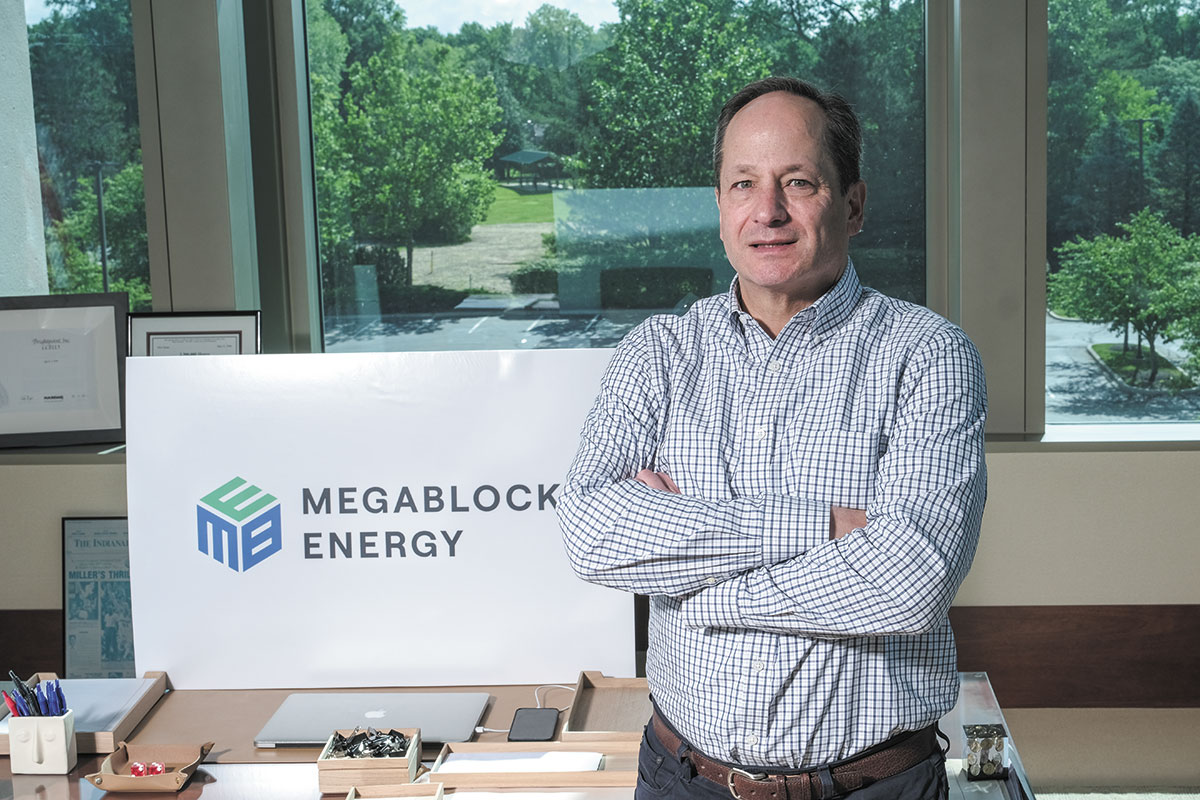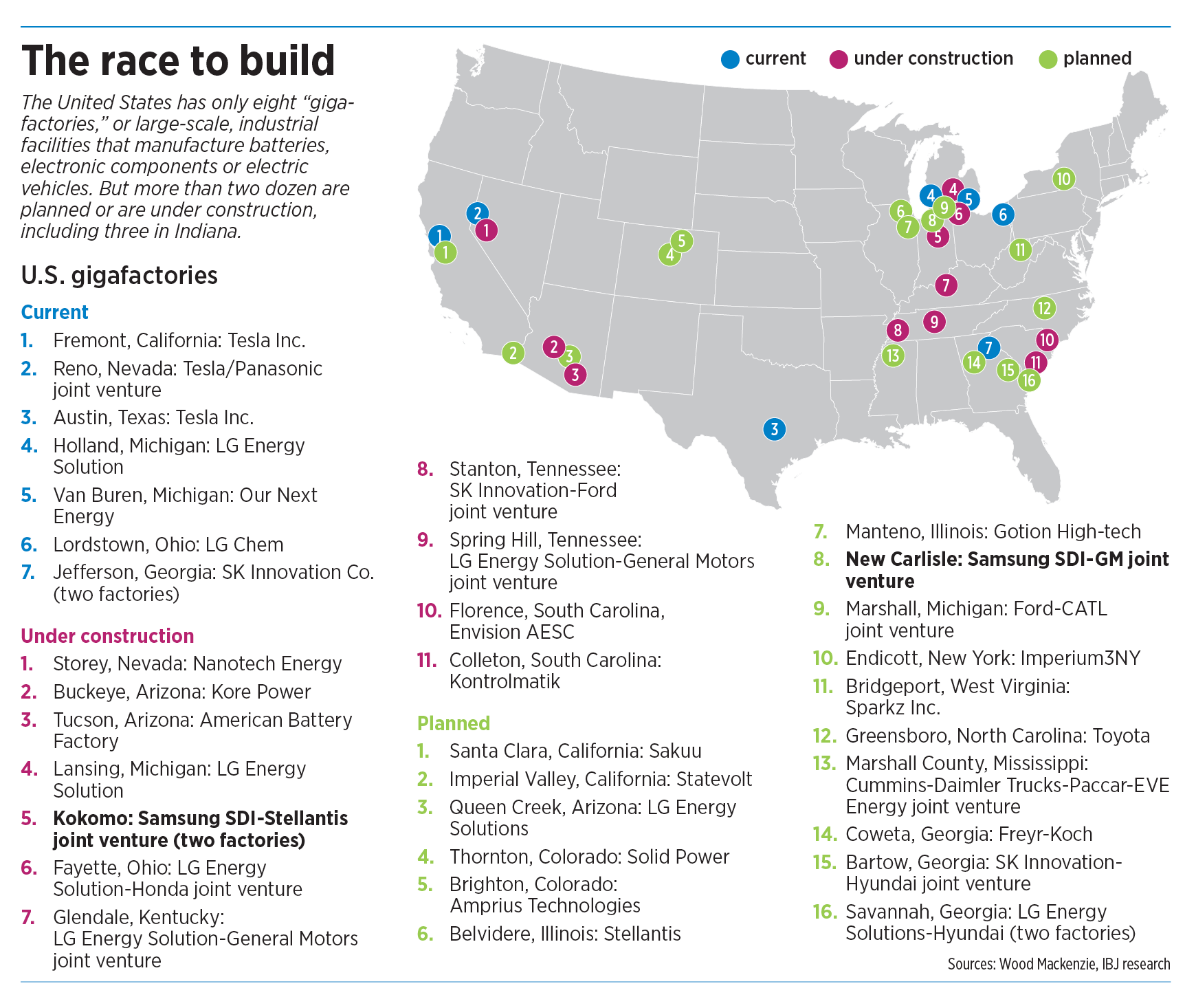Subscriber Benefit
As a subscriber you can listen to articles at work, in the car, or while you work out. Subscribe Now
Robert Laikin and Larry Paulson are at it again.
The two longtime business partners who made their fortunes in the cellphone industry are turning their sights to manufacturing high-density batteries for industrial uses, a booming industry as the nation increases its appetite for electrical power.
Across the United States, companies are scrambling to find ways to store electricity. Meanwhile, dozens of factories to produce batteries and related products are springing up.

Much of it has been in response to the Inflation Reduction Act, which offers grants, tax credits and low-cost loans in exchange for investment in domestic energy production, with a focus on clean energy, including batteries.
Laikin and Paulson last month formed a Carmel-based company, MegaBlock LLC, with a mission to manufacture high-density batteries that can store renewable energy from solar and wind power.
“We’re talking about industrial batteries, not batteries that go into your remote control,” Laikin said. “They could be for a variety of solutions. It might be for utility companies that need backup battery storage. It could be batteries for generators for a Walmart store or a Home Depot.”
Paulson said other markets could be microgrids—or large, cargo-train-size boxes filled with industrial batteries—which utilities are installing to help with peak demands for electricity.
“In addition to the utilities, you have the large server companies, like Google and Facebook and Apple and others,” he said. “And they need to run power into those server farms.”
The two are looking for sites around the country, possibly including Indiana, to build at least two large factories of up to 300,000 square feet each to produce batteries. Each factory could employ more than 400 workers, they say. They aim to start production next year or early 2026. If they find success, more factories could follow.
Laikin said Indiana is on the short list of possible sites, along with some other Midwestern states, plus South Carolina, Texas and Arizona.
It’s an audacious goal and one that likely will require tens of millions of dollars to set up and equip factories. But in separate interviews with IBJ, Laikin and Paulson each said they are not looking for investors. Instead, they plan to self-fund the company initially, while exploring a wealth of incentives offered under the Inflation Reduction Act.
“We’ve done a lot of investing together,” Paulson said. “We have done a number of different initiatives together.”
The company is still in its very early stages. It has only five employees, including Laikin, who lives in Indianapolis, and Paulson, who lives in suburban San Diego. The three others are a chief technology officer, a vice president of real estate and a vice president of strategy. The company’s website went live on Wednesday.
Yet Laikin and Paulson have been able to develop a vision and are in the midst of developing a business plan. They have also assembled a board of advisers that includes real estate developers, investment bankers and software executives.
The two partners are attempting to get a foothold in an industry that is growing by double-digits. The global market for lithium-iron phosphate batteries, the sector MegaBlock is entering, is valued at $12.7 billion and is poised to grow at a compound annual growth rate of 15.7% from 2023 to 2032, according to Precedence Research.
Increasing demand
Some analysts say the growing demand for electricity for everyday uses, as well as the green transition to renewable sources such as solar and wind power, is putting pressure on the battery market.

“The demand for electricity initially skyrocketed because of electric vehicles,” said Roger Lee, director of research at Columbus-based Kirr Marbach & Co. “And then in the past two years, AI got hot, [which required] data centers to process all the artificial intelligence queries. That’s growing electrical demand way, way, way more than the supply.”
In recent years, China has dominated the global battery market, cornering many regional markets for lithium and throwing up factories. The batteries from a single large Chinese producer, CATL (short for Contemporary Amperex Technology Co. Ltd.), today power one in three electric vehicles worldwide, supplying brands from Tesla and BMW to Volkswagen and Ford, according to the Financial Times. The company’s energy-storage products have been successfully applied in large-scale industrial, commercial and residential areas.
Now, the U.S. government is trying to increase domestic production of battery storage systems and decrease U.S. reliance on foreign countries.
The Biden administration’s Inflation Reduction Act includes clean energy tax incentives designed to help low-income communities and other regions that have historically depended on the fossil fuel industry for jobs or been harmed by pollution. It provides up to a 30% credit for qualifying investments in wind, solar, energy storage and other renewable energy projects as well as other incentives.
“The goals of the program are to increase clean energy facilities in low-income communities, encourage new market participants, and benefit individuals and communities that have experienced adverse health or environmental effects or lacked economic opportunities,” according to a fact sheet from the U.S. Treasury Department.
In a two-step approach, the federal government is trying to increase U.S. power in the world of industrial and automotive. First, it wants to use a variety of economic incentives to give the advantage to companies that invest in the United States over companies that are importing into the country.
Second, it is raising tariffs on certain products, including electric vehicles, that are being imported in an effort to keep U.S. products competitive and workers employed.
Tech transfer
Laikin and Paulson are hoping to transfer their success in the cellphone industry to a different type of technology.
The two have worked together at numerous companies and enterprises in different roles. Laikin has focused on the sales, marketing and deal-making side of things, while Paulson has been more of a technology specialist. And the two aren’t shy in talking about it.
“We have this incredible, complementary skill set,” Laikin said. “We’ve entered a few businesses in our career and been wildly successful.”
“Bob and I both came from the cellphone industry,” Paulson said. “That was one of the industries that sort of changed the way that society behaves and works.”
Laiken founded what would become his biggest success just a few years out of college, in 1989, when cellphones were brick-like. He built the Indianapolis-based Brightpoint, a wireless and logistics company, into an operation with $5.2 billion in annual sales, 4,000 employees and facilities in 24 countries before agreeing to sell to Santa Ana, California-based Ingram Micro Inc. for $840 million in 2012.
The deal brought Laikin about $14 million. After the sale, he stayed at the company for seven years in a variety of support and advisory roles.
Paulson started his career at Nokia Corp., a Finnish telecommunications company, where he worked for more than two decades, rising to senior vice president of the mobile phone unit.
He then joined Laikin at Brightpoint, where he worked as executive vice president and chief marketing officer for about two years until the company was sold. He then took a job at Qualcomm, a U.S.-based semiconductor company, where he oversaw smartphone, tablet and laptop device design for Qualcomm worldwide.
A few years ago, Laikin and Paulson joined forces during the craze of SPACs—or special purpose acquisition companies, sometimes called “blank check companies.”
They co-founded two SPACs and raised nearly $400 million between them, taking the SPACs public with the goal of merging each one with a hot-growth startup that would revolutionize an industry and bring them and their investors even greater riches.
The companies the SPACs selected, however, have struggled, losing hundreds of millions of dollars in market value.
The first one, a 3-year-old greenhouse operation called AppHarvest that aimed to revolutionize farming, posted a string of losses and went bankrupt last summer. The company liquidated its assets and used the proceeds to pay back some of its creditors.
The bankruptcy also canceled all outstanding shares of AppHarvest’s common stock, leaving investors who hung on for the long haul an empty bag.
The second company is a California startup called Energy Vault Inc. that is building massive towers to store and release windand solar energy to provide long-term renewable storage. But the operation has posted big operating losses: $106.7 million last year, up from $63.1 million a year earlier. Its shares were trading this week at $1.20, far below their initial public offering price of $10.
Despite the setbacks, Laikin called the two SPAC deals “wildly successful” for many of his investors who bought and sold at the right time.
“Some of the investors decided they wanted to invest for a long-term investment,” he said. “And anyone who invested long term in either of those deals lost a lot of money.”
Others, he said, sold AppHarvest near its high of $42 in 2021 and Energy Vault near its high of $22 in 2022. “I know people who made millions and millions of dollars because they got out,” Laikin said.
He added: “There’s no rhyme or reason. Sometimes people speculate. Different people have different pain tolerances.”
But Lee at Kirr Marbach said claims about making people wealthy through SPACs that stumble or fail are disingenuous.
“Philosophically, I don’t like it when people rationalize and say: ‘Certain investors timed it well and sold to other investors and got rich,’” Lee said. “It’s just that certain investors were able to dump their shares on someone else. That’s not creating value. It’s destroying value.”

Jay Ritter, a finance professor and SPAC expert at the University of Florida, said horror stories are common about startups that merged with SPACs during the recent cooling-down period.
“In many cases, the companies have failed to live up to the optimistic expectations that were built into the price,” he said. “A pretty large fraction has declined in price substantially, including by 90% or more, and some have gone bankrupt. It’s been rough.”
Trying to move fast
As Laikin and Paulson talk about plans for their battery plants, it becomes clear that they are in a hurry. Other players have jumped into the U.S. market with huge deals in the past two years, and they don’t want to be left behind.
Today, the United States has only eight “gigafactories,” or large-scale, industrial facilities that manufacture batteries, electronic components or electric vehicles.
But more than two dozen are planned or are under construction, including three in Indiana: two factories in Kokomo under joint ventures between automaker Stellantis and South Korean battery maker Samsung SDI and a factory in New Carlisle, under a joint venture between General Motors and Samsung SDI.
Laikin and Paulson say they have no intention of entering the electric vehicle market. But it’s clear they are paying attention to the flurry of activity in industrial-scale and electric vehicle batteries and want to get into the game to serve other industrial markets.
“I would say that if you put everything together, a year from now we should have shovels in the ground and be in construction mode,” Paulson said. “And we should be able to have production sometime in late 2025 or early 2026.”•
Please enable JavaScript to view this content.


